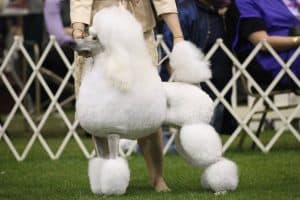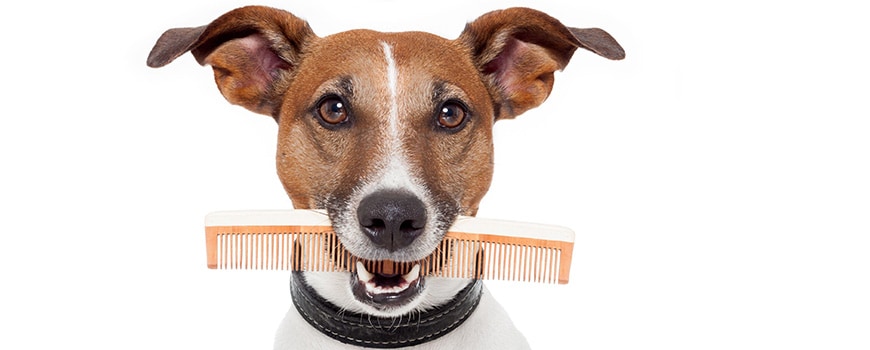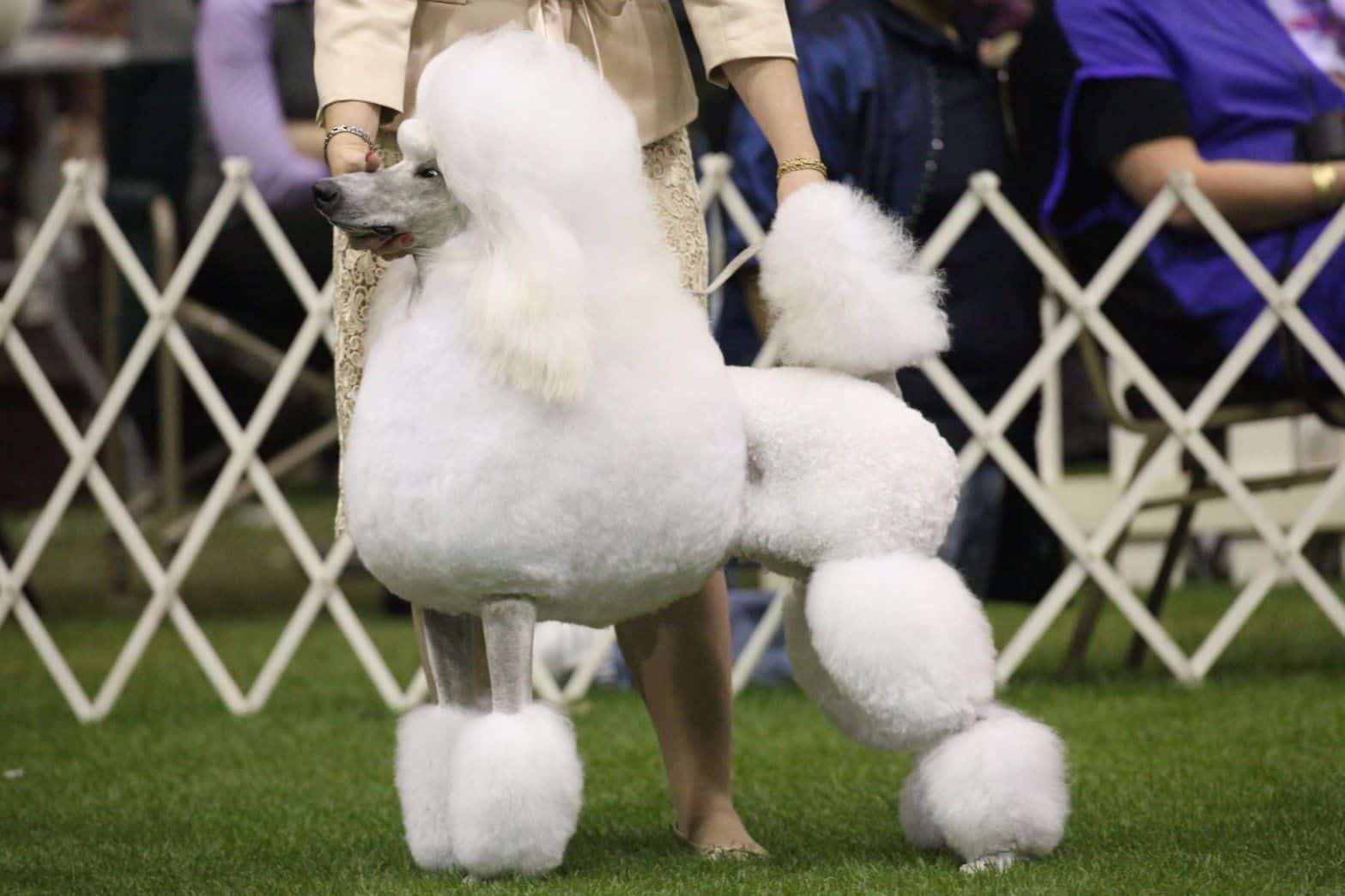If you are a beginner and have never attempted the English Saddle clip for your Poodle, here is some advice. The English Saddle clip is the most difficult of the show clips to execute. It requires superior scissoring and clipping skills and takes more time than any other trim to accomplish.
Although the basic pattern for this clip is the same for all Poodles, the placement of the lines and the finishing touches depend on the proportions of each individual Poodle. It’s very easy to make mistakes if you are not accustomed to dealing with a long show coat—errors that can take months and months of waiting for the hair to grow back.
To set the pattern initially, you might consider having a professional handler trim your Poodle into the English Saddle clip, establishing the lines that are correct for your particular dog, and then start trimming. No matter how much accurate step-by-step grooming information you read, it is never the same as seeing it done.
If a Poodle is dark-colored, most professionals like to trim the clipped areas with a #40 blade about three to four days before a show. This allows the shaved areas to grow back looking velvety smooth by the day of the show.
If a Poodle is white or light-colored, or can’t take a close clip with a #40 blade, use a #15 or #30 blade, and do all of the clipping the day before the show. To avoid irritation after clipping, especially if you use a #40 blade, swab the skin with a canine anti-itch lotion, or with a little Bactine or Vaseline Intensive Care Lotion.
Here are the steps for the English Saddle clip:
- Bathe and blow dry the hair straight.
- Follow instructions for clipping the feet. Clip to the end of the foot; not up on the ankles. While the standard states that the entire shaven foot should be visible, until you master the look you desire, it’s better to leave the clipped line lower rather than to take too much off.
- Follow instructions for clipping the face. On the sides of the head, be sure the clipped line is straight between the outer corner of the eye to the ear. This automatically sets the topknot line on each side.
- Clip the tail and shape the pompon. On all the show clips, you want to leave as much hair as possible to shape into a pompon. A good rule is to clip about one-quarter of the tail and leave hair on the remaining three-quarters to be shaped into the pompon. Stand your dog on the grooming table with the hindquarters facing you. Hold the end of the tail in your free hand. Starting on the upper side, place your clippers flat against the skin and clip in to the tail’s juncture with the body. Some handlers and exhibitors like to clip an inverted V slightly forward of the base of the tail, into the body coat to make the dog look shorter in back. If you do this, be careful not to go too far and clip off too much hair. Clip the sides of the tail in to the tail’s juncture to the body. The underside of the tail is a very sensitive area and should be clipped in the opposite direction, from the body out to the pompon. The clipped line around the tail must be even or the pompon won’t look properly shaped. Hold the tip of the tail in your free hand and fluff the hair out with a comb. Use curved shears to shape the pompon very full and round.
- Place the Poodle in a sitting position facing you to clip the throat. It should be trimmed into a V shape. Start at a point in the middle of the throat, a little below the Adam’s Apple, and clip each side of the neck up to the front of each ear. Because this is a sensitive area, if your Poodle clipper burns easily, make the V in the opposite direction, by starting at the base of the ear and clipping downward to the middle of the throat. Adjust the V upward or downward, depending on the length of your Poodle’s neck.
- Stand the Poodle on the grooming table. The first step in the English Saddle clip is to make a part completely around the dog in back of the last rib with a knitting needle or tip of a rat-tail comb. The hair in front of the part, called the mane, will remain long (to be shaped round, later on). The hair in back of the part, called the pack or saddle, will be scissored into a short plush finish. It’s complex to explain exactly where on your dog’s body to part the hair. It should be se
 parated where it keeps the dog in balance, and this spot varies with the individual dog. Try making the part 1/2 inch in back of the last rib on a Toy Poodle, about 1 inch in back of the last rib on a Miniature, and about 1.5 to 2 inches in back of the last rib on a Standard. Then step back and look at the dog. If he looks out of balance, adjust the part line forward or backward. It’s usually necessary to experiment a little until the dog looks balanced. Once the part is made, brush the hair in front of the part upward. To protect it and keep it out of the way while you trim the hindquarters, especially if you are a beginner, push the long hair forward and spray it with a little hair spray, or wrap a strip of VetWrap around the back and under the chest.
parated where it keeps the dog in balance, and this spot varies with the individual dog. Try making the part 1/2 inch in back of the last rib on a Toy Poodle, about 1 inch in back of the last rib on a Miniature, and about 1.5 to 2 inches in back of the last rib on a Standard. Then step back and look at the dog. If he looks out of balance, adjust the part line forward or backward. It’s usually necessary to experiment a little until the dog looks balanced. Once the part is made, brush the hair in front of the part upward. To protect it and keep it out of the way while you trim the hindquarters, especially if you are a beginner, push the long hair forward and spray it with a little hair spray, or wrap a strip of VetWrap around the back and under the chest. - Comb the hair on the back and scissor it a little shorter, to make it easier to visualize where you’re going to set the pack and form the back bracelets.
- Clip the stomach. Pointing clippers upward, start just above the testicles or vulva, and clip up to the part line near the middle of the dog.
- The hindquarters are covered with short, plush hair, except for a crescent-shape clipped area on each flank and two clipped bands on each back leg. There is a bracelet below the hock joint and one above the hock joint, ending at the stifle joint.
The bands between the bracelets are always set first with shears and then clipped in. Begin by setting the lower band to form the bottom bracelet. Starting just above the hock joint, scissor a narrow band completely around the leg. It is not necessary to clip a Toy, but if you are working on a Miniature or Standard Poodle, use one of the narrow cutting blades to clip carefully over the scissored area. Pointing clippers upward, shave around the leg in short strokes, making the band about 1/4 inch wide. The leg is hollowed above the hock bone, so you must place your finger on the opposite side of the leg when you clip and press the hollowed part forward. - Clip the upper band. Use your fingers to feel for the center of the stifle joint. Scissor another band at this spot, completely around the leg at the same level. You may have to place the band slightly higher or lower if your Poodle is short- or long-legged. Once again, if you are trimming a Miniature or Standard Poodle, point clippers upward and clip around the leg, at exactly the same level, in short strokes, making the upper band about 1/4 inch wide.
- Clip the bands on the other hind leg. Make sure both legs are even. When viewing the dog from behind, both clipped bands should be symmetrical lines from across one leg to the other.
- Comb the hair below the hock joint on each back leg to begin shaping the bottom bracelet. Comb the hair down, then scissor around the clipped line to remove any untidy ends. If the dog does not have great feet, leave a little more hair at the bottom of the bracelet for camouflage. Then comb the hair up and scissor off any untidy hairs above the shaved band. Comb the hair outward, then use curved shears to shape each bracelet. When viewed from the side, the bottom bracelets are more oval than round in shape, sloping downwards from the back of the leg towards the front, emphasizing angulation. When viewed from behind, the bracelets should make the legs appear straight and parallel.
- Shape the upper bracelet. This bracelet is slightly larger than the lower one. Comb the hair down and scissor off any untidy hairs that fall below the clipped line at the bottom of the bracelet. Comb the hair up, and scissor off any hair that extends over the clipped band around the stifle joint. Fluff out the hair with your comb, then, using curved or straight shears, trim the bracelet into a modified oval shape. Hold your shears flat against the hair you are working on, taking a little hair off at a time. Do not dig into the coat with the points of the shear. Don’t pull out the hair with your fingers or you will spoil the plush look. If you are not satisfied with the shape of the bracelet, recomb the hair and begin scissoring again. Scissor the upper bracelet on the opposite leg even in size and shape.
There are several ways to camouflage subtle faults here (you should not show a dog with major faults). If the dog is a little wide in the rear, leave more hair on the insides of the bracelets and less hair on the outsides. If the dog is a little narrow behind, do the opposite, leaving more hair on the outsides of the bracelets and less on the insides. If the hocks tend to turn in (causing the feet to turn out), build up the hair on the outside of the bottom bracelet and shorten the hair on the inside. If the hocks turn out slightly (causing the feet to turn in), do the reverse. If the dog hocks are slightly curved and not straight up and down, lengthen the hair at the bottom of each rosette to make the hocks appear straight. Of course, all these steps should be done in a subtle, not obvious, manner. - Comb the hair on the top of the pack upward. The pack should join the mane with only the part line as a separation. The top and sides of the pack are shaped square and flat. It seems easier to begin by scissoring the top of the pack (from the base of the tail up to the mane) flat. Comb the hair upward and outward to lift it as much as possible, then scissor it flat and plush to a length of about 1/2 to 1 inch, depending on the variety of your Poodle. Comb the hair outward and downward on the hindquarters under the tail. This part of the pack is scissored to appear slightly rounded and blends gradually with the flat, squared top part in front of the tail. Comb the hair down at the clipped band around the stifle joint, then scissor off untidy hairs that fall below the shaved band.
- To complete the pack, clip a crescent-shaped indentation (sometimes called the kidney patch) over the flank on each side of the dog, between the top and underside of the body. Clipping the crescents can be confusing for beginners. The front of each crescent connects to the part line at the mane. The circular part of the crescent should not extend back beyond the point where the rear leg joins the body. If you are unsure of yourself, mark the shape of the indentation with chalk, or scissor the line into the hair. Then clip the crescent using one of the narrow cutting blades to avoid making a mistake. Comb the hair near the clipped areas forward, and scissor off untidy ends that obscure the crescent shape.
- Turn the Poodle around to stand facing you to clip the puffs on the forelegs, which should be in balance with the bracelets on the rear leg. Begin at a point level with the lower rear bracelet, and clip the front and sides of each foreleg up to the point of the elbow. To take off the hair evenly, clip the back side of each foreleg in the opposite direction, from the point of the elbow down to the bracelet line. If you are a beginner and are unsure of where to begin clipping, stand the dog the way you will pose him in the ring. Then scissor a little mark in the hair, even with the rear bracelets. You might even want to set the front puffs a little higher than usual until you determine the correct line. You can always move the line downward, but it can take months of growing hair to move it upward!
- Comb the hair on each front puff. Comb the hair down and scissor around the foot to remove any straggly hairs that fall below the clipped line. As you did on the rear, if the dog does not have ideal feet, leave a little more hair at the bottom for camouflage. Then comb the hair up, and scissor off any untidy hairs above the clipped line around the leg. Fluff out the hair with a comb and then shape the puffs with curved shears. The front bracelets should be longer from top to bottom than they are wide. They are beveled at the top and at the bottom with curved shears and trimmed into the shape. When you have finished, the puffs on the front legs and the bracelets on the rear legs should be in proportion to each other and create the illusion that the legs and feet are straight and parallel when viewed from the front of the back of the dog.
- Stand the Poodle on the grooming table the way you will pose him in the ring. Comb the mane outward for its final shaping. The length of the mane varies with the individual dog. You can make shaping easier by the way you prepare the long hair. Begin by combing it upward and outward around the neck. As your hand moves backwards, comb the hair upward and slightly forward toward the head. Comb the sides of the body outward and slightly forward. Comb the hair on the chest outward and downward, and on the underbody downward and forward. As you scissor and shape the mane, think of circles and balls. Essentially you will be drawing a circle, only you’re doing it with shears. Use curved or straight shears. Hold them flat against the hair; don’t point the tips into the coat. Most professionals begin to shape the mane round by starting underneath and scissoring upward. Trim the hair around and under the elbow fairly short and tight. You don’t want excess hair in this area to dangle or flip out while the dog is moving around the ring. When you reach the front of the chest, shape it round and tight. An excessive amount of hair here will make the dog look dumpy and long in body. If the Poodle has a straight front, however, be careful! Taking off too much hair will call attention to this fault. You also want to lift each ear and trim the mane a little shorter underneath to make the ears lay flat against the body coat.
- Put up the topknot. Instructions and photographs for doing this are in Chapter 19, “CaIf the topknot is too long, it may be trimmed shorter to create a better balance to the mane and to frame the head.
Brush and comb the ear feathering downward. Trim off any uneven ends with your shears, if necessary.

